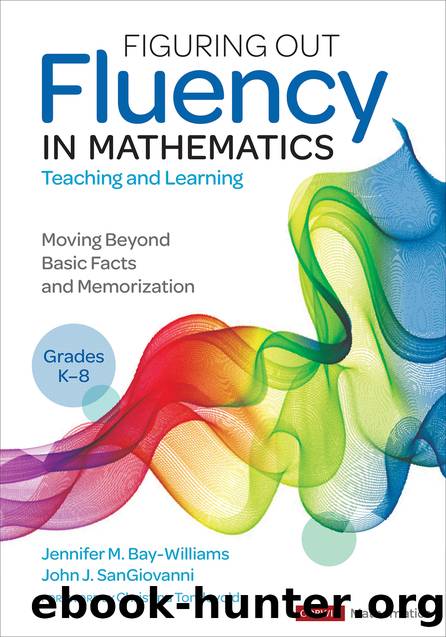Figuring Out Fluency in Mathematics Teaching and Learning, Grades K-8 by Jennifer M. Bay-Williams & John J. SanGiovanni

Author:Jennifer M. Bay-Williams & John J. SanGiovanni [Jennifer M. Bay-Williams & John J. SanGiovanni]
Language: eng
Format: epub
Publisher: SAGE Publications
Published: 2022-11-21T09:31:26.585378+00:00
Chapter 5 Automaticity Beyond the Basic Facts
Procedural fluency has been traditionally viewed as speed of computation and quick recall. And while we know these are not fluency, there is value in effortless recall of concepts, useful strategies, and facts. Consider these three examples:
A second grader is adding $0.75 + $0.19 + $0.25 + $0.05. She rearranges the addends without thinking about it because she âjust knowsâ that 75 and 25 equal 100. Adding 19 and 5 is easy for her, too, so she finds the sum to be $1.24. Her classmate adds each in the order and spends time regrouping and counting. Another rearranges because she sees 5 and 75 but is then left with another problem to think about.
A fifth grader solves 3.86 + 2.28 by seeing 0.86 as 0.14 away from 1.00. She knows that 14 is half of 28, so 0.14 is half of 0.28. She rethinks the problem as 4.00 + 2.14. One classmate breaks the numbers apart by place value and recomposes. Another uses an algorithm. Both make a place value error.
A seventh grader is solving proportions. He comes across . He knows these are equivalent. He then âseesâ the 7s in 42 and 35, so becomes and p is 5. His tablemate cross-multiplies and divides. He arrives at the same solution but takes significantly longer, as 6 à 35 and 210 ÷ 42 take some time to complete.
Download
This site does not store any files on its server. We only index and link to content provided by other sites. Please contact the content providers to delete copyright contents if any and email us, we'll remove relevant links or contents immediately.
Macmillan Primary Grammar 2 Pupil's Book by Unknown(409)
Figuring Out Fluency in Mathematics Teaching and Learning, Grades K-8 by Jennifer M. Bay-Williams & John J. SanGiovanni(366)
The Principal's Guide to Curriculum Leadership by Sorenson Richard D.;Goldsmith Lloyd M.;Mendez Zulma Y.;Maxwell Karen T.;(291)
Learning from Accidents 3rd ed by Trevor Kletz (2001)(254)
English Grammar Practice--The Noun by Roxana Nastase(251)
Harnessing Technology for Deeper Learning by Scott McLeod(245)
Text-Dependent Questions, Grades K-5 by Douglas Fisher & Nancy Frey & Heather Anderson & Marisol Thayre(229)
A Guide to Curriculum Mapping by Hale Janet A.;(227)
English Language Program Administration by Unknown(218)
How to Do Everything with Google Tools by Unknown(212)
Deep Change Leadership by Reeves Douglas;(207)
The Grammar Teacher's Activity-a-Day by Jack Umstatter(199)
The Power of SMART Goals by Conzemius Anne;O'Neill Jan; & Anne Conzemius(192)
Beyond the RTI Pyramid by Bender William N.;(173)
Aligning and Balancing the Standards-Based Curriculum by Squires David A.;(172)
Using Data to Close the Achievement Gap by Johnson Ruth S.;(168)
Differentiated Instructional Strategies for the Block Schedule by Gregory Gayle H.;Herndon Lynne E.; & Lynne E. Herndon(165)
Using Equity Audits to Create Equitable and Excellent Schools by Skrla Linda E.;McKenzie Kathryn B.;Scheurich James Joseph;(165)
You've Got to Reach Them to Teach Them by Schreck Mary Kim; & Schreck(157)
